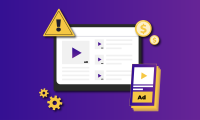Maximizing Revenue in 2023: 10 Metrics Every Publisher Must Track
Metrics are the compass that publishers can rely on to navigate through the complexities of the publishing industry and float the economic currents in 2023. They help understand how customers move through the sales funnel and what factors influence their behavior. Engagement metrics provide insights into the level of interaction between users and publishers. It is a powerful tool for improving customer attribution, monetization opportunities, and content performance. To make the most of metrics, publishers should focus on narrowing down their choices and selecting the most relevant engagement metrics that matter most to their business goals.
Here are the top 10 metrics that every publisher must track to maximize their ad revenue in 2023.
- Stickiness
In today’s digital landscape, there’s no shortage of websites that can attract readers with flashy headlines and clickbait content. However, the ones that stand the test of time are the ones that offer real value and keep readers engaged over the long haul. When readers keep coming back to a website, it’s a surefire sign that the content is striking a chord with them and keeping them hooked. Publishers must prioritize this metric to gain insights into the loyalty and engagement of the audience, as well as the effectiveness of the website’s content and marketing strategies. The formula to get the stickiness metric is: Daily Active Users (DAU) divided by the total Monthly Active Users (MAU).
- First-week engagement
The first few days of engagement between publishers and readers are crucial, much like any first impression. This engagement metric reveals how likely readers are to return, making it a critical component of content strategy planning. Publishers should prioritize creating content that generates high first-week engagement to maximize reader retention and attract a loyal audience. They can use this information to prioritize topics that perform well during the first week and create more content around them. Additionally, they can adjust their publishing schedule to optimize content impact and ensure that it reaches their target audience at the most opportune times.
- Pageviews
Basics are the classics. Hence, publishers should always keep an eye on pageviews, a timeless metric of the publishing industry. It is a simple metric that gives a deep insight into consumer behavior, content trends, and performance. Pageviews are the cornerstone engagement metric that can make or break a publisher’s success. It is often the first sign of how their content is performing and can provide insights into audience engagement and behavior. Other metrics are built on top of page views, making it a critical indicator of a publisher’s overall performance. Without a strong pageview count, it can be difficult for publishers to attract and retain a loyal audience, generate revenue, and grow their brand.
- New vs Returning Visits
Growth and retention, both these factors help in building a sustainable user base. By analyzing the balance of new and returning visitors, publishers can gain insight into the long-term relevance of their content. A high number of returning visitors indicates that the content is resonating with readers over time, while a high number of new visitors suggests that the content is fresh and attracts a wider audience. Publishers can use a combination of strategies such as optimizing their content for search engines and social media to attract new visitors and creating high-quality, relevant content to encourage repeat visits.
- Average time spent
By understanding the average time spent on content, publishers can gain insights into the content as well as overall website performance. This information can be used to create more engaging content and keep readers on the website for longer periods of time. Additionally, publishers can identify any issues with page design or user experience that may be causing readers to leave too quickly. In short, tracking the average time spent on content can help publishers improve user engagement, increase pageviews, and ultimately boost revenue.
- Scroll depth
Scroll depth is a crucial engagement metric for publishers as it reveals the level of user engagement and interest in their content. By analyzing this metric, publishers can gain insights into how much of their content users are consuming and whether they are engaging with it enough to scroll through the entire webpage. Scroll depth is the perfect metric to gauge the relevance of the content to the target audience.
- Bounce rate
Bounce rate is a measure that signifies the proportion of visitors who leave a website after visiting only one page. Digital publishers can calculate this metric by dividing the number of single-page sessions by the total number of sessions within a certain period. A high bounce rate indicates that visitors are not finding the website’s content engaging or relevant enough to continue exploring more content on the website. This could be due to a variety of reasons such as poor website design, slow loading times, irrelevant content, or lack of clear navigation. A high bounce rate can also negatively impact a website’s search engine rankings, making it harder for potential visitors to find the site in the first place.
- Click-through rate (CTR)
Click-through rates (CTR) are an important metric to gauge both the content well as ad performance. CTR is the percentage of users who click on a specific link or call to action (CTA) out of the total number of users who viewed the page. A high CTR indicates that the content or ad is relevant and compelling to the audience, while a low click-through rate could indicate the scope for improvement in the messaging or design. Publishers can use this metric to optimize their content or ads and improve their overall performance as well as ad revenue.
- Conversion rate
Conversion can be the final step in the customer acquisition process. It is the point at which a potential customer takes the desired action, such as making a purchase or signing up for a newsletter. The higher the conversion rate, the better because it means that a larger percentage of website visitors are taking the desired action, such as making a purchase, filling out a form, or subscribing to a newsletter. This can lead to increased revenue, improved customer loyalty, and a higher return on investment (ROI) for marketing efforts.
- Mobile optimization metrics
As mobile usage continues to rise and 5G becomes more widespread, it’s crucial for publishers to prioritize mobile optimization for their websites and ad formats. In 2023, the average global monthly smartphone usage is projected to reach 19 GB, and by 2028, it’s expected to hit 46 GB. Additionally, there will be an estimated 7.33 billion mobile users worldwide in 2023. Given this increasing reliance on mobile devices, publishers must pay close attention to mobile optimization metrics, including page speed, user engagement, revenue, and traffic share.
Metrics serve as a means of communication between publishers and users, providing insights into user behavior, preferences, and interactions. Analyzing and interpreting the engagement metrics is as crucial as tracking them. Numbers hold significant importance, and it is essential for publishers to leverage them to take necessary actions to improve their content and website.




Leave a Reply